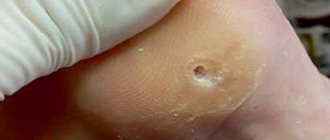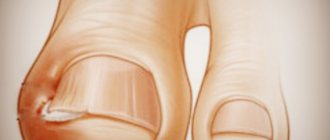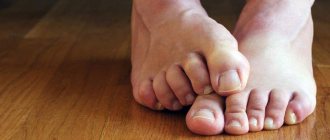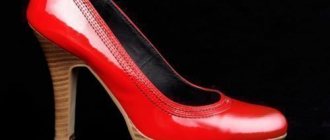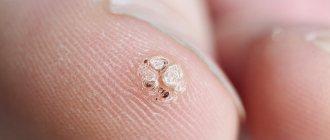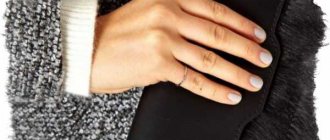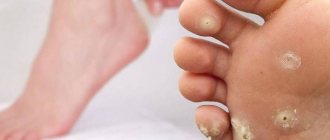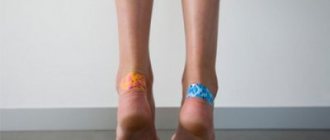In the article we discuss a callus on a foot bone. You will learn what causes the pathology and what symptoms accompany it. We will tell you what types of calluses there are. By following our advice, you will learn ways to prevent and treat corns using pharmaceutical drugs and traditional medicine.
Callus on a leg bone. Photo.
Causes of calluses on a foot bone
Corns on the foot bone are areas of hardened and insensitive skin. Most often they appear due to increased dryness of the epidermis.
The main reasons for the appearance of calluses on the side bones of the feet are tight or hard shoes. Frequent and prolonged walking in high heels can also trigger the formation of corns.
A callus on the bone of the big toe can appear as a result of congenital or acquired pathologies of the structure of the foot. These include severe injuries and flat feet.
Lack of vitamin A also provokes the development of calluses on the bones of the toes. This vitamin is responsible for the growth and development of epidermal cells.
Impaired metabolism in diabetes mellitus has a negative impact on the condition of the skin, which can lead to the formation of corns on the bones of the feet. With this disease, excess weight is often observed, which aggravates the situation or may even be an independent cause of the pathology due to the increased load on the arch of the foot.
The cause of dry calluses on the bones of the feet can be fungal diseases and psoriasis. The epidermis damaged by the disease begins to thicken and, if untreated, quickly passes into the corns stage.
Laser callus removal
Dry callus can be removed with a laser. The event is carried out under local anesthesia. Indications for such removal are callus pain, itching, presence of blood and cracks, redness, swelling, and change in color.
Similar article - Treatment of toe calluses - removal methods
Callus removal is carried out:
The laser procedure in both cases lasts 10 minutes. Instead of a callus, a wound forms on the skin, which heals quickly without leaving a scar. One session is enough for the callus to completely disappear. This method of removal is painless and prevents the recurrence of the formation.
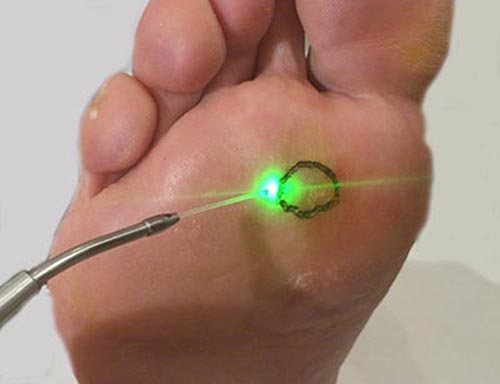
The procedure has contraindications. Thus, calluses are not removed with a laser if the functioning of the immune system is impaired or if there is cancer. If a person has diabetes. Removal is prohibited due to herpes located at the location of the callus, as well as during pregnancy and lactation.
Types of calluses on the foot bone
Calluses on the bones of the feet are divided into two groups: wet (watery) and dry. They differ not only in appearance, but also in the method of treatment.
A watery callus on the top or bottom of the toe bone is characterized by the presence of a bubble filled with fluid. Lymphatic fluid accumulates under the peeling skin. If the bubble turns red, this indicates vascular damage. This type of callus causes severe pain.
It is not recommended to break the integrity of the bubble yourself. This can lead to infection and a number of complications. If left untreated, the callus may progress to the stage of dry corns.
A dry callus on the bone of the toe appears due to mechanical stress, for example, due to uncomfortable or tight shoes. It forms gradually over a long period - from several weeks to a year.
As a rule, such a corn is quite hard and has a yellow or grayish tint. See what a dry callus on a foot bone looks like in the photo.
At the initial stage, this type of callus does not cause serious inconvenience. If the cause of the formation of corns is not eradicated, over time they can become much larger and deeper. This is how core calluses appear. They are a rough seal on the skin of the foot with a depression inward.
Corns can form on any part of the feet, toes, or heels. Most often, calluses with blisters appear on the little toe bone.
How to treat a dry callus on a foot bone
In order to find out how to cure a callus on a leg bone, you need to consult a specialist. Self-medication may not give the expected result and will ultimately make the situation worse.
In modern medicine, there are many ways to treat calluses on the bones of the toes. Depending on the stage of the disease and the nature of the pathology, doctors recommend traditional medicine methods and folk remedies. Let's look at the main ones.
Professional methods
If a callus on a leg bone has reached an advanced stage, surgical intervention may be required to treat it. During the operation, the core of the callus is drilled out.
To eliminate old corns, laser therapy or cauterization with liquid nitrogen (cryotherapy) is used. These highly effective methods of combating calluses are used only in cases where other therapeutic methods do not help.
Laser therapy lasts 5-7 minutes, cryodestruction - no more than 2-3 minutes. After the procedures, the epidermal cells are quickly restored, leaving no scars or scars.
Pharmacy products
In pharmacies you can find a wide range of pharmaceuticals for the treatment of calluses and corns. To combat this disease, salicylic acid (available in tablets and ointments), sodium hydroxide and celandine-based products are most often prescribed.
To treat soft calluses, baths with potassium permanganate and 2% boric acid are used. The procedure helps soften rough skin and has antibacterial and anti-inflammatory effects. After the bath, your feet should be moisturized with any nourishing cream.
Anti-callus patches
You can find anti-callus patches on sale. Their advantage is that, along with a moisturizing effect, they create a protective barrier, thereby preventing infection from reaching the callus.
The patch reduces friction and pressure on the corns. This is especially important for wet calluses with blisters.
Ointments and creams
Before treating a callus on a foot bone with ointments and creams, the skin must be softened. This will enhance the penetration ability of drugs. To do this, make steaming baths with soda, salt or pine extracts.
After the procedure, dry your skin with a towel and treat your feet with a pumice stone or a special file. This way you will remove the keratinized layer of cells. Then apply moisturizer or ointment.
The most commonly prescribed treatment is 10% salicylic ointment. It is applied in small quantities exclusively to damaged areas of the skin and left overnight. You can also use zinc or ichthyol ointments, Vishnevsky ointment.
Folk remedies
A naturopath will tell you how to get rid of calluses on your toe bones using traditional medicine. Contact him for advice so as not to harm your health and not aggravate the situation by self-medicating.
Despite the fact that folk remedies are natural, they also have contraindications for use and a certain algorithm for use, which must be familiarized with in advance. Let's look at recipes for remedies for calluses that can be prepared at home.
Ingredients:
- Wax - 5 gr.
- Laundry soap - 5 gr.
- Pumpkin seeds - 5 pcs.
- Sunflower oil - 1 tablespoon.
How to prepare: Peel and chop the pumpkin seeds, grate the laundry soap and mix. Melt the wax in a water bath, add a mixture of soap and seeds to it, and simmer under the lid for 15 minutes. Before removing the broth from the stove, add vegetable oil and stir. Cool the product at room temperature.
How to use: Apply the ointment to the affected areas of the skin twice a day. To enhance effectiveness, leave the product on the skin overnight.
Result: The ointment softens rough skin, eliminates pain and relieves inflammation.
Callus with a core - treatment of pathology
A callus on the toe causes a number of pain sensations.
It is difficult to respond to medication and therapeutic measures, especially when infected with a fungal virus.
The formations require consultation and diagnostic examination by a doctor. He will determine the type of growth and select the correct treatment.
The specialist may prescribe the following therapy:
- Professional means include drilling, laser or cryodestruction.
- Pharmacy drugs.
- Folk remedies that are especially effective in complex combination.
Of all the listed methods of therapy, the services of a medical institution are especially effective for core growths. The doctor will remove the formation with special, sterile instruments without damaging healthy tissue, completely destroying the ingrown rod. The small remaining root helps to localize the growth again.
Children's feet are prone to dry calluses. Growths appear if the child often walks barefoot, wears wet socks or uncomfortable shoes.
If you notice that recent dropsy has developed into dry keratinization, you should consult a doctor. Taking these steps will prevent deep damage to the skin and eliminate the risk of plantar warts. The doctor will prescribe painless, quick therapy, which may involve the use of a medicinal patch.
If the callus does not go away, grows, or causes pain, there may be an infection. The diagnosis can be made by a dermatologist. If ingrowth or modification of the formation is detected, laser removal is prescribed.
At home, the baby will be helped by prepared: soda baths, aloe juice, baked onion with sugar, compresses with grated raw potatoes, powdered aspirin and lemon juice.
Traditional medicine is quite effective in the fight against dry callus. The presented mixtures are applied to the steamed legs, covered with paper (compressor paper), and strengthened with a bandage. For calluses on the feet, medicinal ointments are applied overnight and a sock is put on top.
In the morning, the solution is washed off with warm water, the damaged areas of the legs are treated with a softening baby cream. A black, small dot in the center of the growth indicates the effectiveness of the treatment!
Core calluses are a growth that goes deep into the tissue. This is an overgrown dry seal. Over time, a root appears and a rod forms.
In some cases, several tubercles with one shaft are formed. Sometimes internal seals appear.
Prevention methods
To prevent calluses on the bones of your feet, choose comfortable shoes. If possible, reduce your time in high heels.
Eat more foods rich in vitamin A. These include dairy products, orange vegetables and fruits, and cod liver.
For the health of the skin on your feet, it is important to systematically moisturize it. Any foot creams with nourishing ingredients are suitable for this.
Don't ignore foot injuries. Treat any bruises and sprains in a timely manner to prevent the development of inflammatory processes and the formation of corns on the bones of the feet.
What to remember
- A callus on a foot bone can appear due to tight and uncomfortable shoes, regular and prolonged stay in heels, excess weight, lack of vitamin A, pathologies of the structure of the foot and skin diseases.
- At the initial stage, corns on the feet do not cause severe discomfort. If you do not treat them, the calluses may deepen, which will complicate the process of restoration of the epidermis and provoke the appearance of pain.
- Before removing a callus on a foot bone, you should consult a doctor. He will select the most effective treatment method in your situation.
—>
Please support the project - tell us about us
Every person in his life has experienced the horror of calluses at least once.
Some people treated water blisters after every shoe purchase, while others were “lucky enough to earn” a core callus.
Be that as it may, the process is quite unpleasant.
If the formation is inflamed, it becomes painful to step on the foot.
Other treatment options at your fingertips
If there is a dry callus on your foot, you can partially get rid of it with vinegar. In order to implement this method, you will need a patch; you need to stick it on the callus and cut a small hole in it according to the size of the callus. Apply vinegar essence to the remaining part of the skin and apply a gauze bandage on top. Often only one procedure is needed.
You can prepare the following ointment: mix pork lard with chopped garlic. Mix until smooth, apply to a napkin and apply to the callus. Wrap with gauze and polyethylene, put on a warm sock on top. Leave the compress overnight. In the morning, treat softened skin with pumice.
What types of calluses are there?
Depending on the impact on the skin of the feet, different types of calluses are formed. They differ not only in appearance, but also in the method of treatment. The following types are distinguished:
- soft (water) has the appearance of a bubble, it is filled with liquid - lymph. It is transparent or has a yellowish tint. The top layer is exfoliated skin.
When the vessels are damaged, the lymph mixes with the blood, and then the bubble has a red tint. This callus is very painful and causes a lot of inconvenience while walking.
The blister can become damaged and eventually turn into a dry callus.
Under no circumstances should you pierce the callus with your own hands. This may lead to infection. This procedure is carried out by a doctor, maintaining complete sterility. Hard (dry) is formed due to prolonged pressure and friction.
At the same time, the skin on which pressure is applied gradually becomes coarser. Unlike a wet callus, a dry callus does not form within a few hours.
This process can take from several weeks to a year.
A hard callus is a keratinized ball of yellow or gray skin. It rises slightly above the skin. Mostly painless, but sometimes cracks form.
When walking or applying pressure, a person feels discomfort and pain.
The main difference is the recess in the center.
This is a rod (root) that grows deep and makes treatment very difficult.
The root can also damage nearby tissues. It causes severe pain. There is another formation that is very similar to a callus - the spine . This is a plantar wart, which is characterized by severe pain, itching and black spots over the entire surface.
A small roll of keratinized skin forms along the edges. The cause is the HPV virus. Treatment is complex and often involves taking medications.
Where are they most often formed?
Calluses on the feet can form in different areas: on the surface of the toes, between them, on the heels, soles, and sides of the feet.
- On the toe . Usually formed due to wearing tight shoes: rubbing of the toes against the shoes, between themselves. Quite often, the little toe suffers from low-quality shoes, which is constantly compressed when walking.
- On the heel . The occurrence is facilitated by frequent wearing of open sandals, shoes that do not fit in size, and rough heels of shoes.
- On the foot . The favorite place for calluses is on the pads under the toes, in the heel area, on the lateral surfaces of the foot. The main reason is high-heeled shoes. As a result, there is a strong load and pressure on the legs. Also, people with flat feet and excess weight know firsthand what inconvenience a callus brings in this area.
Where does a hard callus appear?
Most often, this characteristic roughening of the skin occurs on:
- Thumb.
- Little finger.
- Soles of feet.
- Heels.
- Fingers.
Moreover, those most susceptible to the formation of such calluses are people suffering from flat feet, joint pathologies, obesity, as well as those whose physiological posture is impaired.
Often there is a pathology such as bunion of the feet (a callus on the big toe, it is also called a callus or just a bone) - this condition is typical for travelers, tourists and catwalk models. What they all have in common is wearing tight/hard shoes that press into the tissues of the toes. The main pressure is borne by the convexity of the joint.
The more the legs are exposed to characteristic loads, the rougher this area becomes. The skin on it is not renewed; it is covered with horny particles. The affected area shines and becomes very smooth. This indicates that the process is progressing, and there is nothing good about it.
Modern methods of treating the disease
Treatment of wet calluses
When treating any type of callus, you must first stop the mechanical impact that caused the formation of the callus. If the integrity of the bladder is not broken, the callus does not require treatment . You can simply cover it with a bactericidal bandage.
But if the bladder is damaged, it is necessary to treat the wound with hydrogen peroxide or alcohol to prevent infection. You should not rip off dead skin; it is better to wait until it dries. Afterwards, soak and lightly separate - this way you will not damage the living skin.
Here you will learn what to do with a wet callus:
Treatment of dry calluses
Getting rid of dry calluses is quite difficult: it will require a lot of effort and time. There are many pharmaceutical anti-corn products: corn patch, bensalitin, salicylic ointment, salipod, etc.
Treatment of calluses is an individual process. If this remedy worked for you, it may not be useful for other people.
Treatment at home takes place in three stages:
- soften dead skin . To do this, use various baths (soda and laundry soap, salt, spruce and pine needles, etc.). In folk medicine, there are many recipes for lotions for calluses. For example: garlic boiled in milk, ointment from the herb celandine, gruel from potatoes and onions. The feet are kept in the bath for about half an hour, and the lotions are left overnight.
- Use a pumice stone to gently remove dead skin . This must be done carefully, without violence. Avoid damaging healthy skin.
- Moisturizing and softening : applying creams and oils.
Video about treating dry calluses:
Treatment of core calluses
If the core is not large, the treatment is no different from the treatment of dry calluses. Mustard baths and celandine juice are quite effective.
Drug therapy
When visiting a clinic, the doctor prescribes ointments, gels and special patches to treat calluses. All these products can be used at home, in a comfortable environment.
Most often, to treat dry calluses, external preparations are used, which contain benzoic, lactic and salicylic acid. They soften the keratinized parts of the skin and disinfect. Characterized by keratolytic properties. Apply only to dry skin and directly to the callus, without affecting healthy skin, on which they can cause a burn. Products in this category are used after steaming the legs. The treated area of skin is sealed with a regular plaster.
Similar article - Erysipelas of the leg - why does it occur?
The patches are an excellent aid in the treatment of dry calluses. They are glued to the growth, after making a foot bath, which softens the keratinized surface. After the water procedure, wipe your fingers dry with a towel and only then apply a patch. The product is kept on the callus from 12 hours to 3 days. As a rule, after three procedures the growth disappears without a trace.
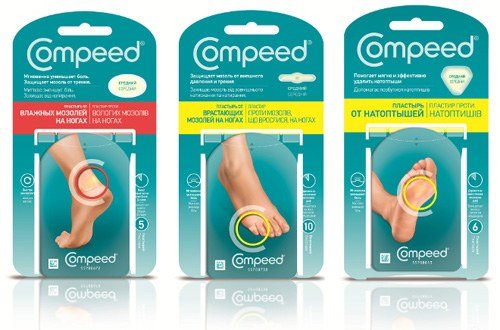
Plasters are used according to the type of callus. Compid is indicated for the treatment of ingrown calluses. It has protective properties and heals. For dry growths, use "Salipod". A product with an antiseptic effect is applied to the wet callus. The most popular are patches with salicylic acid. They have an anti-inflammatory effect. They soften the skin, disinfect, and can act for up to three days.
Wet calluses are first disinfected with an antiseptic: hydrogen peroxide, Furacilin or Chlorhexidine. Do not use preparations containing alcohol for treatment. They will make the pain worse. After disinfection, the formation is sealed with a bactericidal plaster. Anti-callus products can be used.
To heal the wound, which often forms at the site of a burst bladder, products with panthenol, as well as Salicylic or Zinc ointment, are used. Levomekol and Solcoseryl ointments have a wound-healing effect.
To speed up the healing of a wet callus, at home, remove all plasters from it so that the air can quickly dry the wound. It is not recommended to pierce the bladder and extract liquid from it, as infection may occur.
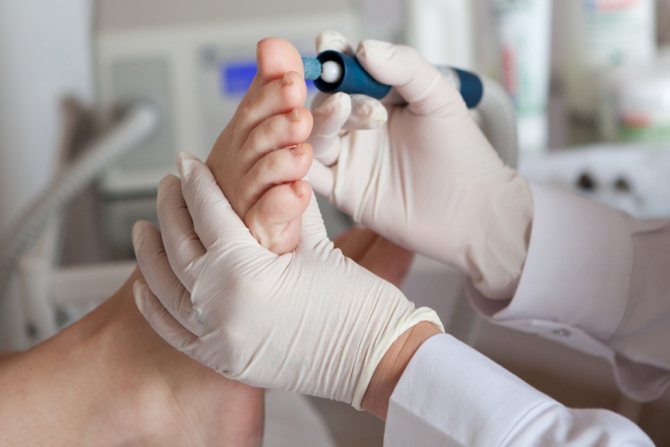
Calluses on the finger can be removed in the salon during a pedicure. For this purpose, the master uses a drill with attachments. It is used to polish the keratinized areas of the skin on the toes. Usually, one session is enough to get rid of the growth.
Is it possible to get rid of skin compaction on a bone?
There is another type of callus: bone callus. It differs in that it occurs not on the skin, but on the bone . The cause may be severe pressure on the bone, often occurring after fractures.
Another name for callus is bone spur. People who are overweight, have a diseased spine, or have pathologies in the joints of their legs are prone to developing heel spurs.
If the callus is large, it causes discomfort when wearing shoes and causes severe pain. Sometimes redness and swelling are observed above the formation.
Get rid of dry calluses forever
Traditional methods of treatment and drug therapy do not always effectively cope with growths. Sometimes their new localization is observed, especially with a fungal infection.
Laser therapy can permanently remove dry core callosum; it is the most effective and safe method of control. The procedure eliminates injuries and pain symptoms in damaged areas.
The laser beam destroys the compaction and root, but all infectious bacteria. Inflammatory processes are not observed, the recovery period is painless and quick.
The advantages of laser therapy include:
- Painless procedure under local anesthesia.
- The keratinization will disappear after one visit to a medical facility.
- The rehabilitation period does not require wearing bandages or using medications.
- The procedure is carried out quickly.
Laser treatment should not be used for people suffering from:
- Oncology;
- Weak immunity;
- Diabetes;
- Pregnant and lactating women;
- For herpes on diseased areas of the skin.
READ MORE: How to quickly get rid of nighttime leg cramps
Consequences of lack of therapy
Treatment of fresh calluses is much simpler and brings positive results faster.
In advanced cases, a lot of effort and time is required.
It may even go as far as surgical intervention. In addition, each type of callus has a number of complications that arise in the absence of therapy.
Without treatment, the water callus can become infected, leading to purulent inflammation.
Also, a soft callus can turn into a dry callus, which can turn into a core callus. And as you already know, only a doctor can remove a deeply embedded rod.
Useful video
And finally, watch a video about preventing this disease on the legs:
There are adults who notice a growing bump on their foot, but do not pay attention until it itches. When someone gets sick, they ask their friends how to treat it. Those who seek advice from a doctor, knowing the possible complications of a bunion, act much wiser.
Attention: statistics estimate that 14% of the population, mostly women, suffer from foot deformity due to a growing bunion at the big toe.
The disease is called hallux valgus, or hallux valgus. This means a curvature of the first metatarsophalangeal joint on the foot. An orthopedic surgeon will make an accurate diagnosis after an X-ray examination. He will determine the stage of the disease based on the characteristic signs and prescribe the optimal treatment.
Diagnostics
Treatment of callus begins after a dermatologist has established an accurate diagnosis, differentiating the disease with a plantar wart or a malignant formation. The diagnosis is usually made by the appearance of the skin defect. At the same time, a blood test is carried out to determine the level of glucose, glycosylated hemoglobin (if diabetes mellitus is not diagnosed), antibodies to the human immunodeficiency virus and papillomatosis. These studies, provided that subsequent treatment for such conditions is prescribed, make it possible to more effectively combat core calluses.
You need to decide how to treat a wet callus only after diagnosis. Doctors conduct an external examination. Additionally, palpation is required. Usually no additional examinations are required.
It is also important to establish the true cause of the violation. Sometimes the deviation is due to internal pathologies. First of all, the doctor will pay attention to the shoes the patient is wearing. If it's not about shoes, the doctor will find out about work activity and physical activity.
We suggest you read What to do if red spots appear on your legs and itch? What do red spots on your legs mean? Types of red spots on legs
Of the instrumental techniques, an x-ray examination of the foot is necessary. This is necessary when the doctor suspects a foot deformity or a disease of the musculoskeletal system. When determining how to treat a water callus, you may need to consult a rheumatologist or orthopedist.
Important! A medical history is required. The doctor is looking for a connection between the callus and possible pathologies of metabolic processes.
Causes of a bunion on the big toe
The essence of the anatomical defect in hallux valgus deformity of the finger lies at the initial stage in thickening of the base, enlargement of the joint due to the accumulation of synovial fluid.
Then the inward deviation of the terminal phalanx of the thumb increases. It hangs over the second and third fingers, squeezing them. And the base, together with the articular part of the metatarsal bone, shifts at an angle to the midline of the body. Bone changes can be felt under the skin.
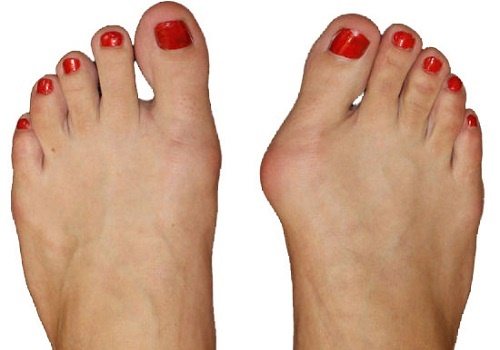
The stage of the pathology is determined by the angle of deviation of the metatarsophalangeal joint. The disease is accompanied not only by local changes. The condition of the ligaments and muscles of the arch of the foot, ankle, and knee joint is impaired.
Adaptation to an upright position and walking helps to redistribute the load on the forefoot. Cartilage tissue and ligaments cannot withstand the weight and become inflamed, causing arthrosis.
Possible causes of toe deformity in adults:
- wearing tight, narrow-toed shoes, high heels (above 5 cm);
- excess weight, which increases the load on the lower limbs;
- hormonal and metabolic fluctuations that weaken bone tissue due to osteoporosis and calcium deficiency;
- previous injuries (bruises, fractures) in the foot area;
- flat feet;
- hereditary predisposition in the form of insufficient structure of ligaments, muscle tissue, and bone strength.
Bunions are sometimes mistakenly called “gout.” But this disease appears due to an increase in the concentration of uric acid in tissues. It more often affects older men. Bone changes in 60% of cases begin with the big toe and involve all small joints. The disease occurs in the form of attacks.
In childhood, the main importance is given to:
- congenital changes caused by an unfavorable course of pregnancy of the mother;
- prematurity of the baby;
- the influence of the baby getting on his feet prematurely;
- lack of vitamin D, causing rickets;
- improperly selected shoes;
- previous injuries;
- inflammatory diseases of the joints;
- complications of childhood infections, especially those affecting the nervous system (poliomyelitis, encephalitis).
Treatment
Calluses need to be treated if they are located on a mobile joint of the toe.
Where it creates unpleasant sensations while wearing shoes. In this case, the tumor is removed by surgical intervention. But surgeons try to resort to such a decision as rarely as possible. This is explained by the fact that the process of tissue proliferation occurs slowly, in the presence of inflammation. The surgeon’s actions lead to an intensification of the inflammatory process, which can lead to an even faster rate of callus growth. The main goal of treatment is to inhibit the process of tissue proliferation.
Medical assistance in solving a delicate problem
For non-surgical treatment, it is advisable for the patient to stay in the hospital. The length of stay directly depends on the severity of the disease, and can range from a month to two. The affected area is fixed so as to exclude the influence of temperature on it and the load is removed. To form healthy bone tissue, the specialist prescribes a diet for the patient.
As part of the treatment complex, the patient is prescribed therapeutic procedures, as well as physical therapy in the form of applying heat to the affected areas. Magnetic therapy is considered the most popular and proven method. Special magnets are applied to the affected areas.
Lack of timely treatment delays the process of recovery of the affected area.
- diabetes;
- heavy weight;
- thrombophlebitis.
- Overweight.
- Heredity.
- Foot injuries.
- Flat feet.
Then comprehensive treatment of the problem will help, including:
- Traditional methods: medicinal baths, compresses, bandages.
- Wearing special medical devices: a fixator, a thumb corrector.
- Physiotherapy.
- Massage.
- Special anti-inflammatory ointments.
- Compliance with preventive measures aimed at preventing the progression of the disease.
Possible consequences of a bunion on the big toe
Symptoms of a growing bone are determined visually and by the sensations of the patients. Appearance:
- the lump is swollen;
- the skin above it is bright pink in color and peels off;
- when palpated and asked to move your fingers, it begins to hurt;
- areas of compaction (corns) are identified on the sole and medial side of the big toe;
- calluses are possible on the outside, most often on the little finger.
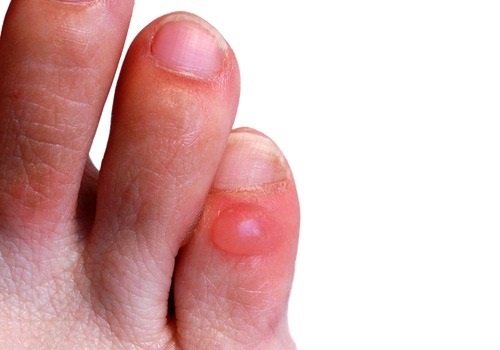
- pain when walking and standing for long periods of time;
- increased fatigue in the legs;
- numbness of the fingers (forced to take off shoes and rub the soles and toes);
- itching in the area of the bump and corns (you constantly want to scratch your leg);
- cramps in the muscles of the foot and leg.
The consequences of a bunion with untreated planovalgus deformity in children manifest themselves as:
- flat feet;
- arthrosis-arthritis of the leg joints;
- curvature of the spine;
- irregularities in the shape (dysplasia) of the pelvic bones;
- risk of osteochondrosis;
- shortening of limbs.
A deformed foot creates conditions for a significant increase in the load on the articular surfaces of the overlying joints. The spine reflexively adapts to the deviation of the leg axis. Therefore, the consequences are detected at school age (scoliosis, lordosis).
Over the years, adults develop local and general problems.
Local consequences include:
- the formation of a callus on the protruding bone and other fingers;
- inflammation inside the joint capsule (arthritis and bursitis);
- dense corns on the sole, heel;
- benign tumors from tendon tissue (hygromas) on the dorsal, lateral and heel surfaces;
- cysts filled with synovial fluid, capable of quickly suppurating and pouring out through fistulous tracts;
- curvature of other fingers.
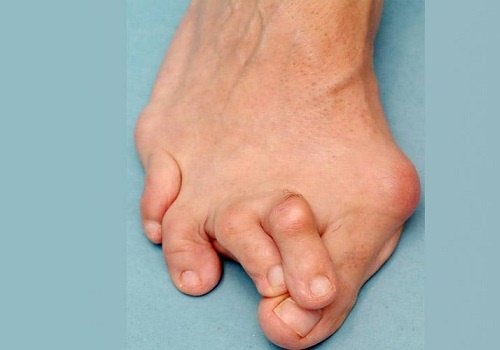
People with foot deformities are at high risk of:
- early osteochondrosis;
- formation of intervertebral hernia;
- arthrosis of the hip and ankle joints.
They are at risk of a sedentary lifestyle, constant severe pain in the joints, and disability due to the inability to self-care and find employment. We will tell you more about some common complications.
Problems with choosing shoes, changes in gait
If there are bumps and calluses, a person adapts to less painful movement. The gait becomes slow and shuffling. Patients prefer to sit on a bench rather than walk. The weight is transferred to the outer side of the foot, which is why they noticeably clubbing. Shoes wear off along the outer edge, causing chafing on the skin.
It is impossible to find the right model in the shoe department of the store. Even if you give up high heels, it is impossible to wear shoes and boots of your own size. You need soft, wide shoes. House slippers and flip-flops are ideal. Other shoes are bought 2 sizes larger.
Orthopedic shoes are made in specialized workshops. If the degree of deformation is small, the doctor will prescribe constant wearing of insoles that allow you to fix the position of the foot. They are purchased according to a doctor's prescription in orthopedic salons and departments.
Calluses and corns
Calluses and corns are formed due to compaction and thickening of the surface layer of the skin. The callus is smaller in size and is localized in areas of friction. They are distinguished by type: dry (with a rod), wet (with liquid inside) and bleeding.
Is it possible to get disability due to a bone?
A medical and social examination decides whether a person has a pathology that corresponds to the percentage of disability or requires the establishment of disability due to permanent loss. Patients who have undergone a full examination and treatment with documents indicating the results and prognosis are referred to the commission.
For sick children with congenital planovalgus foot and protruding bone, the disability criteria are:
- moderate dysfunction of skeletal muscles;
- physical curvature leading to limitation of independent movement.
The severity of violations is assessed quantitatively:
- 10–20% - if there is a moderate degree of deformation, special shoes allow you to correct the position of the foot;
- 40–60% - if the deformity is severe and fixed, treatment is ineffective, correction with shoes is impossible, and there are complications.
For adult patients, disability is established in cases of impaired ability to move and self-care.
Disability due to pathology
Patients of working age are issued a certificate of incapacity for work during the period of exacerbation of the disease, inpatient treatment, and postoperative rehabilitation. For sanatorium treatment, you will need to use the duration of your next vacation, and a certificate of incapacity for work will compensate for the missing days.

An employment certificate is issued. Work related to the following is not recommended:
- physical activity;
- walking and standing for long periods of time;
- hypothermia of the legs.

